Dynamic Relationship between Agricultural Water Use and the Agricultural Economy in the Inner Mongolia Section of the Yellow River Basin
Abstract
:1. Introduction
2. Study Area, Data, and Methods
2.1. Study Area Overview
2.2. Data Sources and Preprocessing
2.3. Methods
2.3.1. PVAR Model Establishment
2.3.2. Unit Root Test
2.3.3. Lag Length Selection
2.3.4. Cointegration Test
2.3.5. Generalized Method of Moments (GMM) Analysis
2.3.6. Granger Causality Test
3. Results
3.1. AWU in the Inner Mongolia Section of the Yellow River Basin
3.2. Agricultural Economy Growth in the Inner Mongolia Section of the Yellow River Basin
3.3. Causality between AWU and the Agricultural Economy
4. Discussion
5. Conclusions
- (1)
- From 1998 to 2018, the average total AWUAWU in the Inner Mongolia section of the Yellow River Basin was 7.521 billion m3, with a significant downward trend of 48 million m3/year. At the same time, AWU efficiency significantly increased during the study period, and major crop yields increased at a rate of 209,100 t/year. AWU efficiency varied greatly across administrative regions, with Hohhot having the highest level of water use efficacy and Wuhai and Bayannur having the lowest.
- (2)
- The agricultural economy of the study area grew substantially between 1998 and 2018, with the growth rate of the primary-sector GDP reaching 2.496 billion CNY/year. As a share of the total economy, primary-sector industries declined to varying degrees across regions.
- (3)
- A stable, long-term cointegration relationship exists between AWU and the agricultural economy growth in the Inner Mongolia section of the Yellow River Basin. Both variables were positively influenced by the previous period. Further, a one-way Granger-causal relationship exists from the AWU to the agricultural economic growth.
Author Contributions
Funding
Institutional Review Board Statement
Informed Consent Statement
Data Availability Statement
Conflicts of Interest
References
- Li, J.-H. Global water shortage and food crisis. Ecol. Econ. 2021, 37, 5–8. [Google Scholar]
- Taghdisian, A.; Bukkens, S.G.; Giampietro, M. A societal metabolism approach to effectively analyze the water–energy–food nexus in an agricultural transboundary River basin. Sustainability 2022, 14, 9110. [Google Scholar] [CrossRef]
- Yang, G.-Y.; Wang, H.; Lv, Y.; Li, S.-Y.; Chang, C. Analysis on the function of national water network construction to guarantee national food security strategy. China Water Resour. 2022, 9, 34–37. [Google Scholar] [CrossRef]
- Leonard, L. Climate change impacts and challenges of combating food insecurity in Rural Somkhele, KwaZulu-Natal, South Africa. Sustainability 2022, 14, 16023. [Google Scholar] [CrossRef]
- Sun, C.-Z.; Jin, C.-Y.; Hao, S. Study on water-energy-food nexus relationship of the Yellow River basin. Yellow River 2020, 42, 101–106. [Google Scholar] [CrossRef]
- Liu, C.-M.; Wei, H.-S.; Zhang, Y.-Q.; Tian, W.; Luan, J.-K. Analysis on the attribution of runoff changes in the mainstream of the Yellow River and discussion on related issues. Yellow River 2021, 43, 1–6. [Google Scholar]
- Lv, J.-X.; Liu, C.-M.; Liang, K.; Tian, W.; Bai, P.; Zhang, H.-Y. Spatiotemporal variations of extreme precipitation in the Yellow River Basin based on water resources regionalization. Resour. Sci. 2022, 44, 261–273. [Google Scholar] [CrossRef]
- Wang, W.-B.; Wang, P.; Wang, H.-H. Promote the economical and intensive use of agricultural water resources and the modernization of irrigated areas in the Yellow River Basin of Inner Mongolia. North. Econ. 2020, 08, 22–66. [Google Scholar] [CrossRef]
- Weitzman, M.L. Comments and Discussion (on “Lethal Model 2: The Limits to Growth Revisisted” by William D. Nordhaus). Brook. Pap. Econ. Act. 1992, 2, 50–54. [Google Scholar]
- Rode, S. Advanced Macroeconomics; Bookboon: London, UK, 2012. [Google Scholar]
- Wang, X.-Y.; Han, H.-Y. Growth drag of water resources to agriculture in China. J. Econ. Water Resour. 2008, 26, 1–5. [Google Scholar] [CrossRef]
- Zhuo, L.; Li, M.; Zhang, G.-P.; Mekonnen, M.-M.; Hoekstra, A.-Y.; Wada, Y.; Wu, P.-T. Volume versus value of crop-related water footprints and virtual water flows: A case study for the Yellow River Basin. J. Hydrol. 2022, 608, 127674. [Google Scholar] [CrossRef]
- Yin, Y.; Tang, Q.; Liu, X.; Zhang, X. Water scarcity under various socio-economic pathways and its potential effects on food production in the Yellow River basin. Hydrol. Earth Syst. Sci. 2017, 21, 791–804. [Google Scholar] [CrossRef]
- Wang, C.-S.; You, F.; Xue, D.-Q. The causes and alleviating countermeasures of the problems of water resources utilization in areas along the Yellow River in Inner Mongolia. J. Nat. Resour. 2002, 17, 579–589. [Google Scholar]
- Yang, G.-Y.; Wang, H.; Li, S.-Y.; Duan, N. Water resources conditions of Inner Mongolia Autonomous Region and measures for water development and utilization. China Water Resour. 2017, 23, 32–35. [Google Scholar]
- Zha, J.-P.; Zhou, Y.; Zhou, X. Coupling and coordination relationship between agricultural water use efficiency and agricultural economic development in the nine provinces(autonomous regions) along the Yellow River. J. Water Resour. Water Eng. 2021, 32, 219–226. [Google Scholar]
- Feng, Y.-W.; Zhen, J.-H. Eco-spatial security optimization in watershed of the Yellow River in Inner Mongnolia. Chin. J. Agric. Resour. Reg. Plan. 2022, 43, 129–138. [Google Scholar]
- Ma, L.; Liu, T.-X. Runoff response to climate change of typical tributary in the Inner Mongolia reach of Yellow River basin. J. Irrig. Drain. 2014, 33, 122–126. [Google Scholar]
- Yue, S.-Y.; Li, H.-E. Study on the marginal benefits of water resources in Baoji section of Wei River. J. Water Resour. Water Eng. 2019, 30, 19–24. [Google Scholar]
- Li, Q.; Chen, H.-M.; Wang, Y.-P. The interactive effect of agricultural water and agricultural economic growth in Xinjiang. Resour. Sci. 2014, 36, 1679–1685. [Google Scholar]
- Zeng, Z.; Han, J.-Q.; Wu, Y.-G. PVAR model analysis of the impact of urbanization on agricultural carbon emissions based on the panel data of Anhui Province. J. South China Agric. Univ. 2021, 26, 176–187. [Google Scholar]
- Zuo, X.-X. Review of the new development of unit root test. Math. Practice Theory 2020, 50, 272–279. [Google Scholar]
- Chu, J.; Zhu, H.-L. Co-integration test of the relationship between international trade and economic growth in China. Med. Decis. Mak. 2020, 36, 116–120. [Google Scholar] [CrossRef]
- Zhang, K.; Deng, X.; Shen, Q.-L.; Qi, Y.-B. Technological progress in agriculture, rural labor transfer and farmers income- analysis of PVAR model based on grouping of agricultural labor productivity. Agr. Technol. Econ. 2017, 06, 28–41. [Google Scholar]
- Ma, A.-H.; Yue, D.-P.; Zhao, J.-B.; Hu, Q. Spatiotemporal variation and effect of extreme precipitation in Inner Mongolia in recent 60 years. Arid Zone Res. 2020, 37, 74–85. [Google Scholar]
- Fu, J.-Y.; Li, H.-Y. Study on the spatio-temporal heterogeneity of agricultural water use efficiency and influencing factors in the Yellow River basin. Chin. J. Agric. Resour. Reg. Plan. 2022, 43, 77–89. [Google Scholar]
- Zhao, L.; Wang, J. Tourism development and economic growth in China: A co-integration analysis on provincial panel data. Tour. Sci. 2015, 29, 40–57. [Google Scholar] [CrossRef]
- Lu, C.-P.; Ji, W.; Hou, M.-C.; Ma, T.-Y.; Mao, J.-H. Evaluation of efficiency and resilience of agricultural water resources system in the Yellow River Basin, China. Agric. Water Manag. 2022, 266, 107605. [Google Scholar] [CrossRef]
- Zhao, J.; Wang, Y.; Zhang, X.; Liu, Q. Industrial and Agricultural Water Use Efficiency and Influencing Factors in the Process of Urbanization in the Middle and Lower Reaches of the Yellow River Basin, China. Land 2022, 11, 1248. [Google Scholar] [CrossRef]
- Jin, S.-Y.; Zhang, S.-Y.; Ma, Z.-J.; Zhang, P. Water consumption in Inner Mongolian reach of the Yellow River since integrated water regulation. Acta Geogr. Sin. 2015, 70, 501–508. [Google Scholar] [CrossRef]
- Hou, Z.-H.; Mei, L.-J.; Hou, A.-H.; Feng, H.-C. Analysis of the regional difference of agricultural resources utilization in Inner Mongolia. Chin. J. Agric. Resour. Reg. Plan. 2016, 37, 160–166. [Google Scholar]
- Guo, H.-Q.; Shen, X.-Q. The three industrial structures development and contribution to GDP in Inner Mongolia. Econ. Issues 2013, 5, 126–129. [Google Scholar]
- Meng, Z.-L.; Xue, Y.; Zhang, Y.-Y. Research on the coupling coordination mechanism between industrial structure and water resources in Inner Mongolia. Yellow River 2021, 43, 67–72. [Google Scholar]
- Tsimelas, G.; Kofinas, D. A resource nexus analysis methodology for quantifying synergies and trade-offs in the agricultural sector and revealing implications of a legume production paradigm shift. Sustainability 2023, 15, 9726. [Google Scholar] [CrossRef]
- Zhang, C.-J.; Zhang, H.-Q.; Chen, Q.-Y.; Gong, Y.-Y. Empirical research on the relationship between water use and economic growth. Resour. Sci. 2015, 37, 2228–2239. [Google Scholar]
- Xia, J.; Liu, B.-J.; Cheng, D.-D. Discussion on water security and high-quality development of Yellow River basin. Yellow River 2021, 43, 11–16. [Google Scholar] [CrossRef]
- Lang, Y.-H.; Wang, L.-M. The types of deficient resources and the trend of supply and demand. J. Nat. Resour. 2002, 17, 409–414. [Google Scholar]
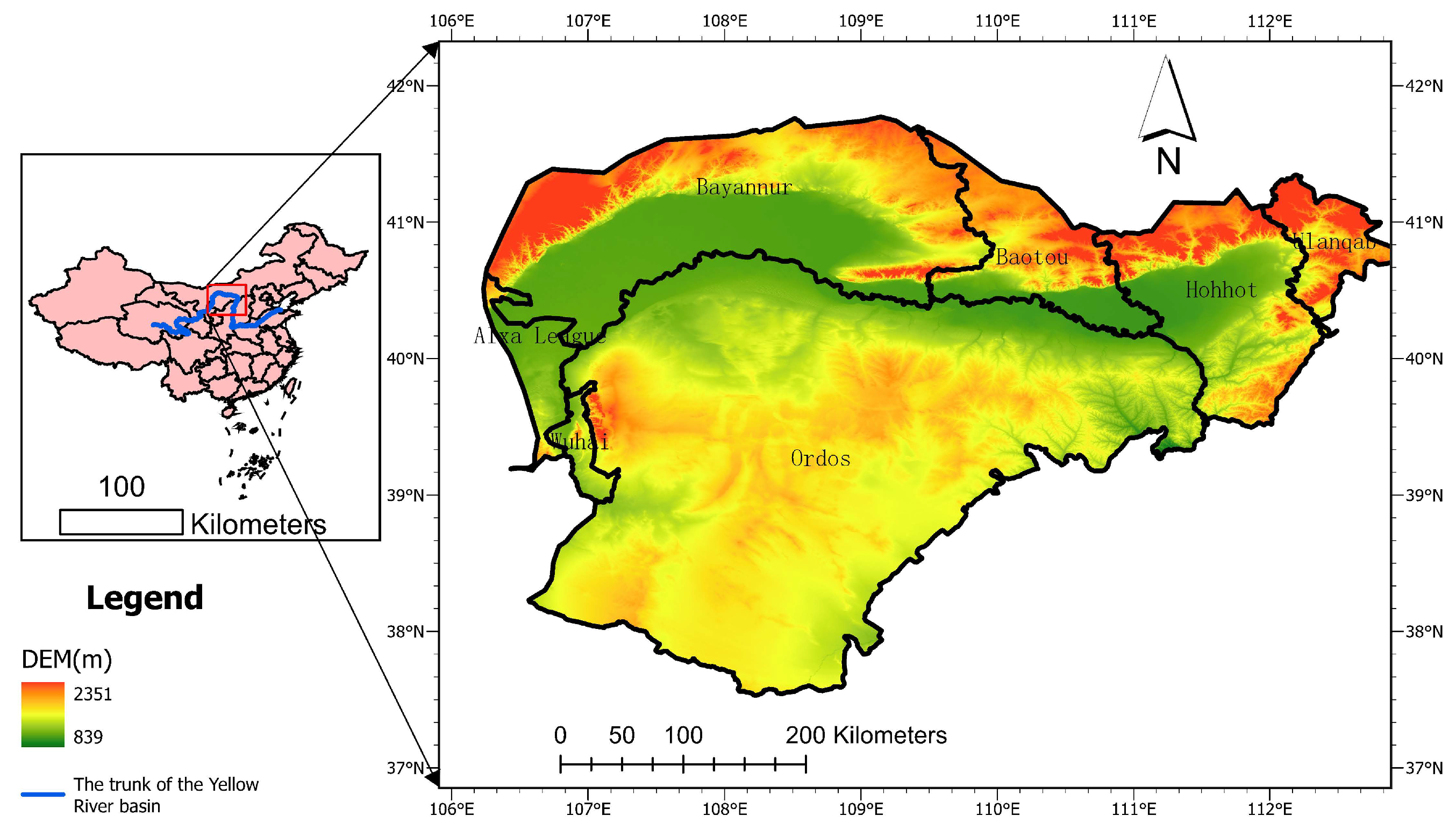
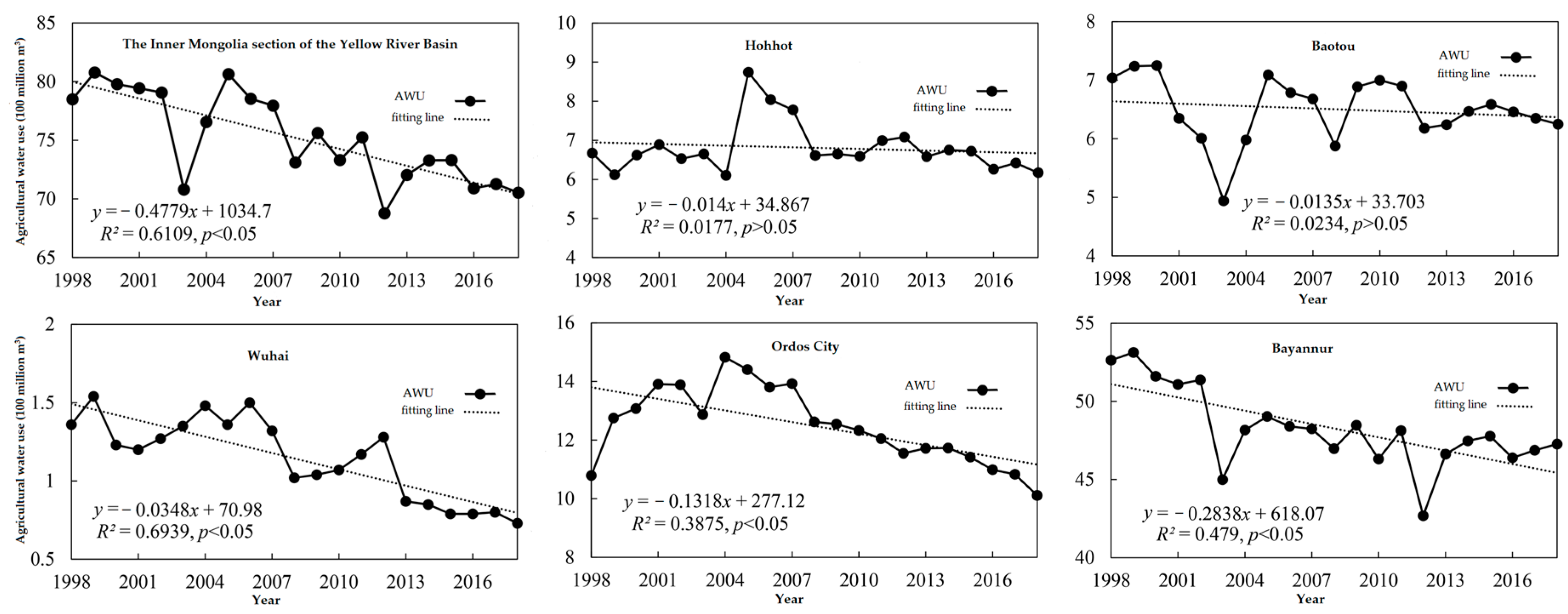
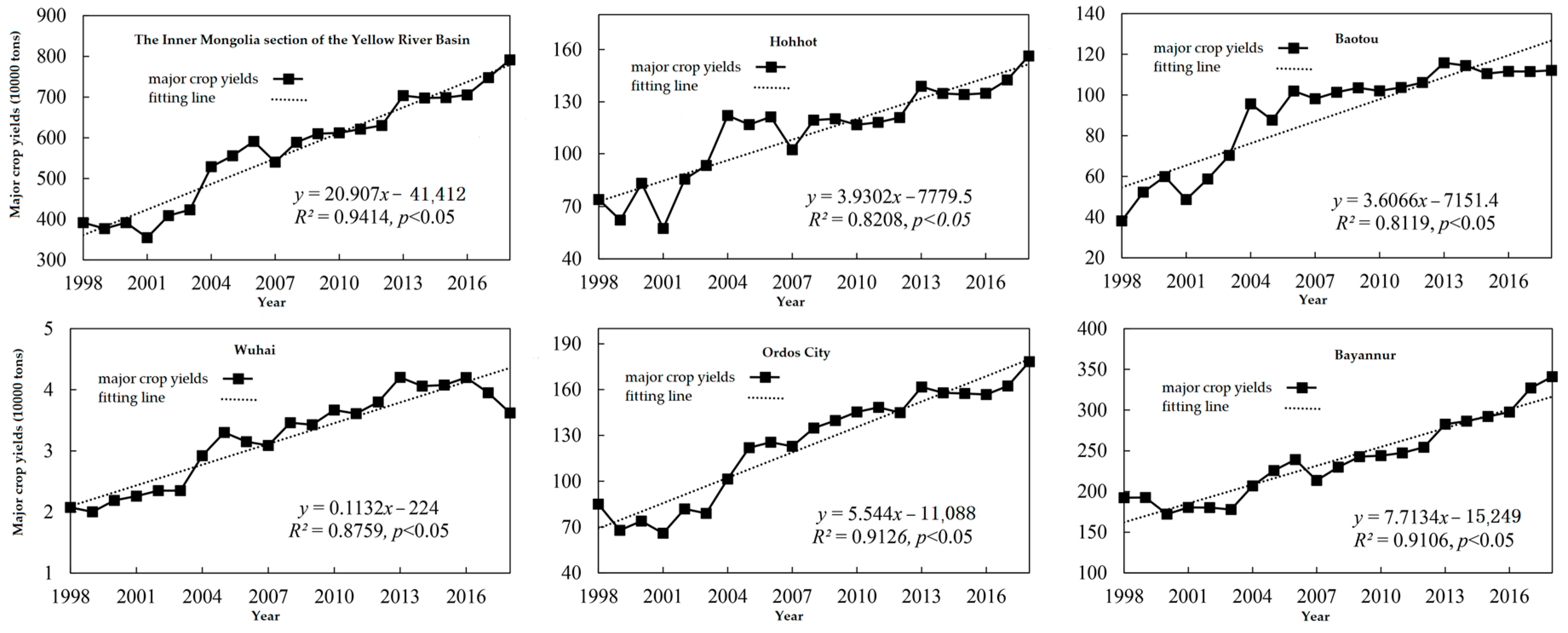
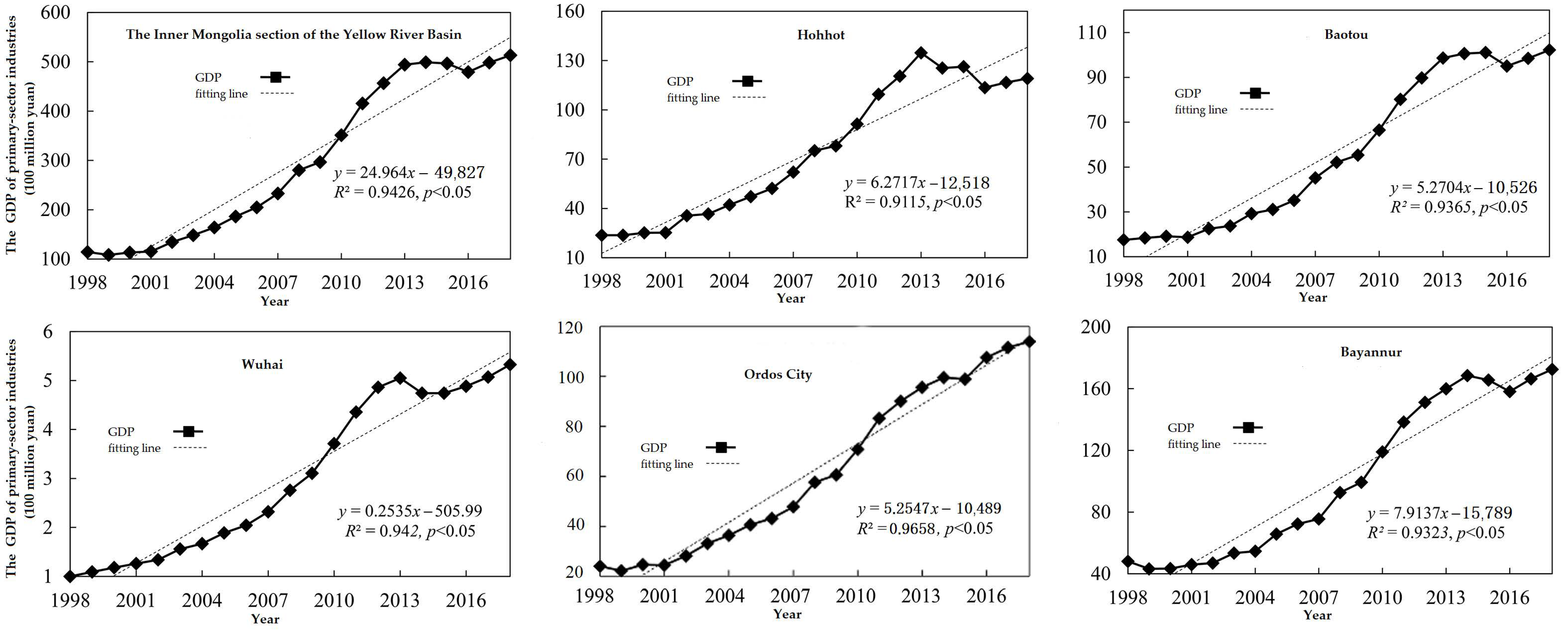
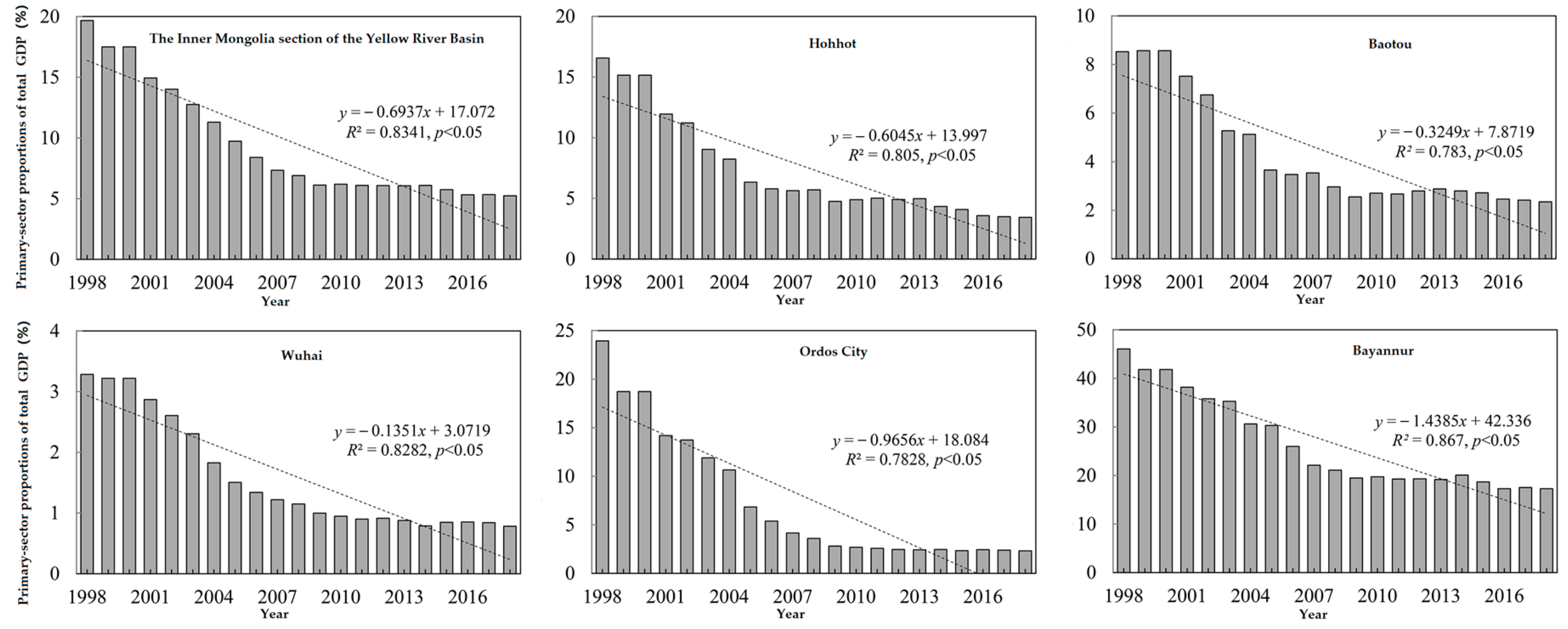
| Agricultural Share of Total Water Use (%) | Crop-Sowing Area (Thousand Hectares) | Agricultural Water Use Output Efficiency (CNY/m3) | Average Agricultural Water Use per Mu (m3) | |
|---|---|---|---|---|
| Hohhot | 60.37 | 457.52 | 29.81 | 193.42 |
| Baotou | 58.41 | 272.78 | 25.31 | 321.10 |
| Wuhai | 28.40 | 5.97 | 11.62 | 689.36 |
| Ordos | 64.77 | 484.43 | 19.01 | 274.09 |
| Bayannur | 92.58 | 741.88 | 6.46 | 482.82 |
| Test | lnW | lnG | dlnW | dlnG |
|---|---|---|---|---|
| Levin–Lin–Chu | −4.45515 *** | 3.98061 | −8.03974 *** | −4.79198 ** |
| Breitung | −0.72391 | 2.83438 | −6.67362 *** | −2.71619 *** |
| Im–Pesaran–Shin | −3.41132 *** | 4.44567 | −8.59939 *** | −3.54276 *** |
| Fisher ADF | 27.7100 *** | 0.53754 | 67.3299 *** | 28.3229 *** |
| Fisher PP | 27.7005 *** | 1.10408 | 79.8469 | 28.5564 *** |
| Within-Group Statistics | Panel v | Panel rho | Panel PP | Panel ADF |
|---|---|---|---|---|
| 1.1530 | −2.7522 *** | −3.4329 *** | −3.3014 *** | |
| Between-group statistics | Group rho | Group PP | Group ADF | |
| −1.3410 * | −2.9741 *** | −2.8715 *** |
| Variables | dlnG | dlnW |
|---|---|---|
| dlnG(−1) | 0.9843 *** | 0.0023 ** |
| dlnW(−1) | 0.0159 ** | 1.0025 *** |
| c | 0.3699 | −0.6476 |
| Null Hypothesis | p-Value | Conclusion |
|---|---|---|
| lnG does not Granger-cause lnW | 0.8254 | Does not reject the null hypothesis |
| lnW does not Granger-cause lnG | 0.0495 | Rejects the null hypothesis at the 5% significance level |
Disclaimer/Publisher’s Note: The statements, opinions and data contained in all publications are solely those of the individual author(s) and contributor(s) and not of MDPI and/or the editor(s). MDPI and/or the editor(s) disclaim responsibility for any injury to people or property resulting from any ideas, methods, instructions or products referred to in the content. |
© 2023 by the authors. Licensee MDPI, Basel, Switzerland. This article is an open access article distributed under the terms and conditions of the Creative Commons Attribution (CC BY) license (https://creativecommons.org/licenses/by/4.0/).
Share and Cite
Ye, Z.; Miao, P.; Li, N.; Wang, Y.; Meng, F.; Zhang, R.; Yin, S. Dynamic Relationship between Agricultural Water Use and the Agricultural Economy in the Inner Mongolia Section of the Yellow River Basin. Sustainability 2023, 15, 12979. https://doi.org/10.3390/su151712979
Ye Z, Miao P, Li N, Wang Y, Meng F, Zhang R, Yin S. Dynamic Relationship between Agricultural Water Use and the Agricultural Economy in the Inner Mongolia Section of the Yellow River Basin. Sustainability. 2023; 15(17):12979. https://doi.org/10.3390/su151712979
Chicago/Turabian StyleYe, Zhigang, Ping Miao, Ning Li, Yong Wang, Fanhao Meng, Rong Zhang, and Shan Yin. 2023. "Dynamic Relationship between Agricultural Water Use and the Agricultural Economy in the Inner Mongolia Section of the Yellow River Basin" Sustainability 15, no. 17: 12979. https://doi.org/10.3390/su151712979
APA StyleYe, Z., Miao, P., Li, N., Wang, Y., Meng, F., Zhang, R., & Yin, S. (2023). Dynamic Relationship between Agricultural Water Use and the Agricultural Economy in the Inner Mongolia Section of the Yellow River Basin. Sustainability, 15(17), 12979. https://doi.org/10.3390/su151712979






